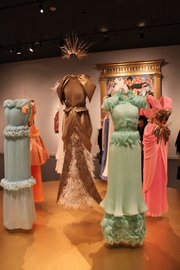Rodarte on Art as Inspiration for Fashion
LACMA Director Michael Govan interviewed Kate and Laura Mulleavy of Rodarte as part of LACMA's Director's Series on January 18. The sisters recently donated their Fra Angelico Collection to the museum's Costume and Textiles Department and spoke about the influence of art, film and literature on their designs. The collection is on display through February 5.
Unlike many designers who spent their childhoods flipping through glossy magazines and dreaming of working in fashion, Kate and Laura Mulleavy didn’t intend on becoming fashion designers.
Fashion was an early interest, but it was mixed in with other pursuits like botany, film, art and literature, and later, political science and medicine.
They grew up with a mushroom botanist for a father and an artist for a mother and went on to study art history and literature at Berkeley.
It wasn’t until after moving back home with their parents after graduation and watching “an endless loop” of horror films for a year that they began their foray into fashion.
“I don’t know why our parents never said anything,” Kate said, when being interviewed by LACMA CEO and Director Michael Govan at LACMA’s Director’s Series on Wednesday. “Looking back, it was pretty strange.”
The Los Angeles-based designers and founders of Rodarte have never fit the norm of traditional designers.
The two sisters share everything, even an email address. They used to share a cell phone until their conflicting preferences for a Blackberry and an iPhone caused them to finally part ways on mobile devices.
Kate went so far as to describe her and her younger sister Laura as “interconnected” and “entwined,” and said that they are “the same person in two different bodies.”
There are subtle differences – Laura thinks in stories and Kate thinks in pictures; Kate is more talkative while Laura uses very few words – but together they’ve created a brand that is coveted by fashion icons and worn by the likes of Cate Blanchett, Keira Knightley and Kirsten Dunst.
Their ideas primarily come from art, imagery, film, literature and nature, not from other designers, they said.
Laura explained that any time she’s tried to take inspiration from another designer, it hasn’t worked and she’s had to abandon the idea.
“I’ve tried, but I’ve had the hardest time looking at something that’s been done and trying to do it in terms of our collection,” she said.
Usually the pair start with an idea, then choose the colors and select about 100 images that they feel tell the story of what they’re trying to convey and then they go about designing the collection.
The images they choose could be anything from pictures of tornadoes to blades of grass, pieces of art, or varying degrees of sunlight.
Their Fall 2008 collection was based on Japanese horror films, ballet and a Helen Frankenthaler painting with a compelling blot of red paint that inspired them to use red in a collection for the first time.
Another collection was inspired by real and imaginary landscapes and the historical use of Technicolor in film. They created “wheat print” dresses that captured the colors from a wheat field during dusk, dawn, midday and stormy weather. Yet another collection was influenced by Van Gogh’s starry skies and views from Pasadena’s Mt. Wilson Observatory.
Art has been one of the biggest inspirations for the sisters, who said that they would often sit at the café at the Norton Simon Museum in Pasadena and sketch their collections.
Their feathered “Black Swan” costumes were primarily inspired by a photograph of an open cube with textured shag walls on the interior. This box, along with the feathers and scarred, wrinkled skin of the California Condor, were two key elements of the film's modern, deconstructed tutus.
The sisters were also influenced by their upbringing in the Northern California seaside town of Aptos and they cite the vampire movie “The Lost Boys” as one of their favorites due to its darkness and ability to capture the 80s hippie/skate/surf scene of the Santa Cruz Boardwalk.
Keeping in line with their attraction to the darker side, Kate explained how arsenic was used in certain coveted color dyes during the Victorian era, which wound up unknowingly poisoning the ladies who wore the colored gowns made with these dyes.
This intense focus on finding just the right shade is something the sisters can relate to, Kate said, especially during the creation of their Fra Angelico Collection, now on display at LACMA.
The sisters aimed to emulate the aged, “chalky” colors used by the Italian Renaissance painter Fra Angelico. Tangerine orange, blush pink, gold, light blue, pale green and gold were some of the shades they used for the crepey chiffon and satin dresses.
The 10 sherbert-colored pieces hang suspended from the ceiling of the museum’s Italian Renaissance gallery, offset by Renaissance paintings and sculptures.
The collection was originally made for the Pitti Immagine Uomo fashion fair in Florence, Italy last June. It was recently donated by the Mulleavy sisters to LACMA’s Costume and Textiles Department. They will remain on display at the museum until February 5.






















